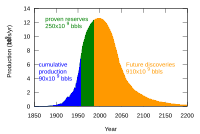
Photo from wikipedia
In order to analyze the productivity effectively and design the reasonable production pressure drop of multi-stage fractured horizontal well (MFHW) in tight oil reservoirs, a numerical simulation model for multi-stage… Click to show full abstract
In order to analyze the productivity effectively and design the reasonable production pressure drop of multi-stage fractured horizontal well (MFHW) in tight oil reservoirs, a numerical simulation model for multi-stage fractured horizontal well is established to account for the threshold pressure gradient (TPG), matrix permeability change due to stress-sensitive effect and dynamic fracture closure. The model adopts local grid refinement to simulate the fractures, based on the production data of a long fractured horizontal well in a tight oil reservoir in Xinjiang oilfield. The complex fracture network is equivalent to a high permeability zone, based on equivalent percolation theory and Warren–Root model. Simulation results illustrate that the reservoirs with multi-stage fractured network can be effectively simulated by this model; productivity analysis shows that well productivity is inversely proportional to the threshold pressure gradient and stress-sensitivity coefficient, and the stress-sensitivity coefficient is proved to be a more influential factor that affects the horizontal well productivity in tight oil reservoirs. In addition, the dynamic closure of primary fracture has significant effects on the optimization of production pressure drop, as it is necessary that the model takes the factor into account to optimize the pressure drop. The reasonable production pressure drop of MFHW can provide the applicable value for the economic exploitation and long-term planning of the tight oil reservoirs.
Journal Title: Journal of Petroleum Exploration and Production Technology
Year Published: 2018
Link to full text (if available)
Share on Social Media: Sign Up to like & get
recommendations!